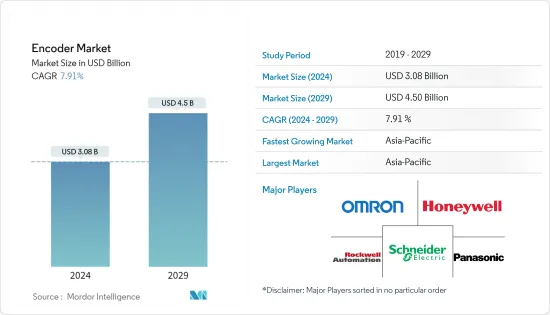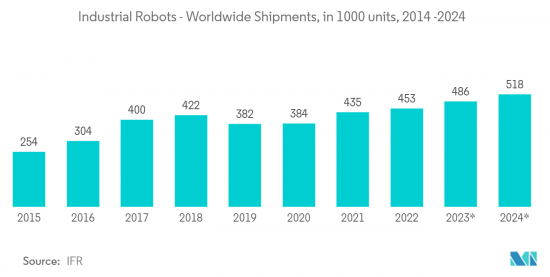 |
市场调查报告书
商品编码
1406086
编码器:市场占有率分析、产业趋势/统计、成长预测,2024-2029Encoder - Market Share Analysis, Industry Trends & Statistics, Growth Forecasts 2024 - 2029 |
||||||
※ 本网页内容可能与最新版本有所差异。详细情况请与我们联繫。
编码器市场规模预计到 2024 年为 30.8 亿美元,预计到 2029 年将达到 45 亿美元,在预测期内(2024-2029 年)复合年增长率为 7.91%。

由于从资料中心到通讯各种应用对编码器的需求不断增加,该市场正在经历快速成长。
主要亮点
- 高端自动化需求和工业4.0是市场成长的关键驱动力工业4.0指的是第四次工业革命,它将工厂自动化从传统资讯技术系统控制的製造工厂转向巨量资料分析和生产云端基础基础设施的虚拟
- 全球许多国家都积极回应,制定策略性倡议,加强工业4.0的实施。例如,SAMARTH Udyog Bharat 4.0 是印度政府重工业和公共企业部根据印度资本财行业竞争力增强计划提出的工业 4.0 倡议。据贸发会议称,中国和美国在工业4.0技术的投资和能力方面处于领先地位。中国和美国拥有最大的数位平台,占市值的90%。
- 此外,编码器是运动控制应用的核心。编码器将位置、速度和方向回馈给控制器和驱动器,提高驱动系统的准确性和可靠性。随着技术的进步,编码器也不断进步,融入了通讯和网路领域的最新发展,为工程师在各种运动控制应用中解决所面临的挑战提供了工具。
- 编码器的最大限制之一是它们相当复杂并且由精密部件组成。这使得它们对机械滥用的抵抗力较差,且耐热性有限。很难找到能够承受 120°C 以上温度的光学编码器。除此之外,功能安全认证很难获得,并且可能会出现与运动控制编码器功能相关的错误,引发人们对运动控制设计中关键功能安全问题的担忧,这也是市场成长的重要限制因素。这些限制为市场成长带来了挑战。
- 自 COVID-19 爆发以来,工业界已转向自动化以减少人力工作并提高效率。例如,主要零售商和杂货店正在寻找加快自动自助结帐系统的方法,以最大限度地减少人际接触并确保消费者和员工的安全。疫情过后,印刷业对自动化和自动化印刷设备的投资也增加。例如,Tim于 2021 年 2 月宣布在芬兰 Kvora 的 LUMON Oy 安装了一条新印刷线。这些变化预计将有助于所研究市场的成长。
编码器市场趋势
工业部门预计将占据大部分市场占有率
- 编码器可用于多种工业应用,包括线性测量、套准标记计时、捲筒纸张力、逆止器测量、输送和填充。最标准的应用是为电动马达的运动控制提供回馈。在工业领域,大量电力用于电动。大多数这些马达都内建编码器。
- 机器人的应用范围越来越广,特别是在焊接、物料搬运、组装和研磨任务中。这些机器人需要可靠的编码器来引导它们的运动,因为人类的监督和监督通常是有限的。
- 根据IFR统计,近年来,中国在工业机器人方面进行了大量投资,机器人密度在各国中不断上升,并首次超越美国。在中国製造业中,运作的工业机器人数量相对于工人数量已达到每万名员工拥有322台。韩国、新加坡、日本、德国和中国是全球製造业自动化程度最高的五个国家。这些行业越来越多地采用自动化预计将进一步推动市场对编码器的需求。
- Strausak AG 等公司正在探索工业机器人技术,特别是如何加速无需操作员的工具研磨和重磨。此应用程式使用夹持臂从紧密堆迭的托盘中拾取小型工具并放回夹具中。手臂的每个轴均配备海德汉感应式EQI 1100旋转编码器。此编码器在夹具尖端提供 50μm 的精度,可安全、快速且准确地定位 10mm 直径的工具。

亚太地区成长迅速
工业化的不断发展以及对更好的製造流程解决方案的需求正在推动市场的快速成长。亚洲拥有日本、中国和印度等大型工业中心,因此生产设备和与公司的服务合约的增加也支持了产业成长。日益激烈的市场竞争导致新产品进入市场,促进市场成长。
- 根据国际机器人联合会(IFR)的报告,亚洲是全球最大的工业机器人市场,2021年引进的新机器人中有74%安装在亚洲(前一年为70%)。该地区最大进口国中国的安装量增加了 51%,出货为 268,195 台。
- 报告称,日本是仅次于中国的最大工业机器人市场,2021年安装量成长22%,达到47,182台。此外,日本是全球领先的机器人製造国之一,日本工业机器人出口数量达到186,102台的新高峰。标准和自订的旋转编码器和线性编码器有效地用于电气医疗设备和测试设备,例如手术台、检查台、伽马刀、X 射线和扫描仪。
- 据印度品牌股权基金会2021称,为了促进医疗保健产业的发展,印度政府(GOI)推出了多项计画来加强医疗设备产业,并加强研发(R&D)和医疗设备投资。 2000年4月至2021年6月,医疗手术器材产业吸收外资总额22.3亿美元。政府对医疗领域的巨额投资可能会推动编码器市场的发展。
- 该地区的汽车工业也占编码器总需求的很大一部分。例如,根据中国工业协会的数据,2022年4月,中国生产了约21万辆商用车和99.6万辆小客车。
- 此外,韩国拥有众多主要汽车製造商,并保持着世界顶级汽车生产国之一和最大汽车出口国之一的地位。此外,该地区的电动趋势正在为市场创造新的机会。
编码器行业概况
许多公司正在进入编码器市场,包括OMRON、 Honeywell、Heidenhain GmbH、Baumer Group 和 Posital Flava。这些公司拥有庞大基本客群的优势,能够大量生产编码器。强大的品牌是卓越绩效的代名词,因此我们预期老字型大小企业将拥有优势。由于竞争公司有能力渗透市场并提供先进产品,预计它们之间的竞争将持续下去。
它是一款革命性的绝对感应式编码器解决方案,可在运动控制应用中实现更高水平的精确角度测量,并在最苛刻的环境中实现机器人的位置反馈。本产品适用于需要精确角度测量但在不适合光学编码器的环境中使用的应用(例如多尘、骯脏、潮湿、高衝击或振动环境)。
2023 年 3 月,POSITAL 宣布对其 IXARC 系列增量式旋转编码器进行重大升级。这种新型编码器可能会透过降低功耗同时保持与旧型号的机械和电气相容性来使客户受益。
其他福利:
- Excel 格式的市场预测 (ME) 表
- 3 个月分析师支持
目录
第一章简介
- 研究假设和市场定义
- 调查范围
第二章调查方法
第三章执行摘要
第四章市场洞察
- 市场概况
- 产业吸引力-波特五力分析
- 供应商的议价能力
- 买方议价能力
- 新进入者的威胁
- 替代品的威胁
- 竞争公司之间的敌对关係
- 产业价值链分析
- COVID-19 对市场的影响
第五章市场动态
- 市场驱动因素
- 先进汽车系统的高采用率
- 工业自动化需求不断成长
- 市场挑战
- 恶劣条件下的机械故障
第六章市场区隔
- 按类型
- 旋转编码器
- 线性编码器
- 依技术
- 光学的
- 磁力型
- 光电式
- 其他的
- 按最终用户产业
- 车
- 电子产品
- 纤维
- 印刷机械
- 工业
- 医疗保健
- 其他的
- 按地区
- 北美洲
- 欧洲
- 亚太地区
- 其他地区(拉丁美洲、中东、非洲)
第七章 竞争形势
- 公司简介
- Omron Corporation
- Honeywell International
- Schneider Electric
- Rockwell Automation Inc.
- Panasonic Corporation
- Baumer Group
- Renishaw PLC
- Dynapar Corporation(Fortive Corporation)
- FAULHABER Drive Systems
- Pepperl+Fuchs International
- Hengstler GMBH(Fortive Corporation)
- Maxon Motor AG
- Dr. Johannes Heidenhain GmbH
- POSITAL FRABA Inc.(FRABA BV)
- Sensata Technologies
第八章投资分析
第九章 市场未来展望

The Encoder Market size is estimated at USD 3.08 billion in 2024, and is expected to reach USD 4.5 billion by 2029, growing at a CAGR of 7.91% during the forecast period (2024-2029).
The market is witnessing rapid growth due to the increasing demand for encoders in multiple applications, from data centers to telecommunication.
Key Highlights
- The need for high-end automation and Industry 4.0 are the major factors driving the growth of the market. Industry 4.0 describes the fourth industrial revolution, a new world where factory automation moves beyond manufacturing plants controlled by conventional information technology systems to a cloud-based infrastructure that permits big data analytics and the virtualization of production processes.
- Many countries worldwide have positively responded to Industry 4.0 by developing strategic initiatives to strengthen its implementation. For instance, SAMARTH Udyog Bharat 4.0 is an Industry 4.0 initiative of the Ministry of Heavy Industry & Public Enterprises, Government of India, under its scheme on Enhancement of Competitiveness in the Indian Capital Goods Sector. According to the UNCTAD, China and the United States are leaders in investment and capacity in Industry 4.0 technologies. They are home to the largest digital platforms, accounting for 90 percent of the market capitalization.
- Furthermore, encoders are central to motion control applications. They can offer feedback on position, speed, and direction to a controller or drive to increase the accuracy and reliability of a drive system. As technology advances, so do encoders, incorporating the latest developments in communications and networking and offering engineers tools to solve challenges they face across a diverse array of motion control applications.
- One of the most significant limitations of encoders is that they can be reasonably complex and comprise some delicate parts. This makes them less tolerant of mechanical abuse and restricts their allowable temperature. One would be hard-pressed to find an optical encoder that will survive beyond 120ºC. In addition to this, rising concern about functional safety issues, which is of significant importance in any motion control design, is also a notable limitation for the market's growth as the acquisition of functional safety certification can be arduous, and there can be some errors associated with the functionality of the motion control encoders. Such limitations pose a challenge to the market's growth.
- Since the outbreak of COVID-19, industries were looking for automation to reduce human interaction and enhance efficiency. For instance, leading retail and grocery outlets explored ways to ensure faster, automated self-checkouts that minimized human contact and kept shoppers and employees safe. Increased investment in automation and automated printing equipment has also been observed in the printing industry, which has been instigated by the pandemic. For instance, in February 2021, Thieme announced that it installed a new printing line at LUMON Oy in Kouvola, Finland, which allowed an automatic adaptation of different glass sizes to be printed without screen change or manual cleaning. These changes are expected to aid the growth of the market studied.
Encoder Market Trends
Industrial Sector is Expected to Hold Major Market Share
- Encoders are utilized in multiple industrial applications, such as linear measurement, registration mark timing, web tensioning, backstop gauging, conveying, filling, and more. The most standard application is providing feedback on the motion control of electric motors. In the industrial sector, a significant amount of electricity goes to electric power motors. Most of these motors have encoders incorporated into them.
- Robots are experiencing a growing number of application areas, especially for operations like welding, material handling, assembly, and grinding. Since there is typically limited human oversite or monitoring, these robots must have reliable encoders to help guide their movement.
- As per the IFR, China's massive investment in industrial robotics in recent years has moved its position up among various other countries for robot density, surpassing the United States for the first time. The number of operational industrial robots relative to the number of workers reached 322 units per 10,000 employees in the manufacturing industry in China. South Korea, Singapore, Japan, Germany, and China are the world's top five most automated manufacturing countries. Such an increase in the adoption of automation in the industries is expected to further fuel the demand for encoders in the market.
- Companies, such as Strausak AG, are exploring industrial robotics, specifically in terms of the ways it can accelerate operator-free grinding and re-sharpening tools. In this application, a gripper arm is used to pick small tools from tightly loaded pallets into the fixture and back. Every axis of the arm includes HEIDENHAIN's inductive EQI 1100 rotary encoder. This encoder allows the accuracy of 50 µm at the tip of its gripper for the safe, quick, and precise placement of tools with diameters as small as 10 mm.

Asia-Pacific to Register Fastest Growth
The growing industrialization and demand for better solutions for manufacturing processes are driving the growth of the market at a rapid pace. As Asia is home to large industrial hubs, such as Japan, China, and India, the increasing production facilities and service agreements with businesses are also propelling industry growth. Increasing market rivalry has resulted in the introduction of new items to the market, which has boosted the market's growth.
- According to a report by the IFR (International Federation of Robotics), Asia is the world's largest market for industrial robots; 74 percent of all newly deployed robots in 2021 were installed in Asia, compared to 70 percent in the previous year. Installations for the region's largest adopter, China, increased by 51 percent, with 268,195 units shipped.
- As per the report, Japan followed China as the largest market for industrial robots; installations increased by 22 percent in 2021, with 47,182 units. Moreover, the country is the world's predominant robot manufacturing country, with exports of Japanese industrial robots achieving a new peak level of 186,102 units. Both standard and custom rotary and linear encoders are effectively utilized in electro-medical and laboratory equipment, such as operating and examination tables, Gamma Knife and X-ray, Scanners, and many more.
- According to the Indian Brand Equity Foundation 2021, to promote the medical industry, the Government of India (GOI) launched several programs to strengthen the medical device sector, focusing on research and development (R&D) and 100 percent FDI for medical devices. Between April 2000 and June 2021, FDI in the medical and surgical appliances industry totaled USD 2.23 billion. Such huge investments by the government in the medical sector will drive the market for encoders.
- The automotive industry in the region also accounts for a significant share of the total demand for encoders. For instance, according to the China Association of Automobile Manufacturers, around 210,000 commercial vehicles and 996,000 passenger cars were produced in China in April 2022.
- Moreover, South Korea has maintained its position as one of the world's top automotive manufacturing countries and one of the largest automotive exporters, owing to the presence of many major car makers in the country. Additionally, the trends toward electrification in the region are unlocking new opportunities for the market.
Encoder Industry Overview
The encoder market comprises various players, such as Omron Corporation, Honeywell, Heidenhain GmbH, Baumer Group, and Posital Fraba Inc., among others. The companies have the advantage of a large client base, enabling them to produce large volumes of encoders, a key factor in ensuring better profits and economies of scale in the sensor market. As strong brands are synonymous with good performance, long-standing players are expected to have the upper hand. Owing to their market penetration and the ability to offer advanced products, the competitive rivalry is expected to continue to be high.
In March 2023, Celera Motion announced the introduction of the Field Calibration IncOder, which is a groundbreaking new absolute inductive encoder solution that enables next-level accuracy angle measurement in motion control applications and position feedback in robotics in the most demanding environments. The product is designed for applications that need precise angle measurements but in conditions not suited for optical encoders: dusty, dirty, and wet environments or in conditions where high shocks and vibrations are common.
In March 2023, POSITAL announced the launch of a major upgrade to its IXARC family of incremental rotary encoders that features new magnetic sensor technology and more energy-efficient embedded microcontrollers. The new encoders are likely to benefit customers by reducing power consumption while remaining mechanically and electrically compatible with earlier models.
Additional Benefits:
- The market estimate (ME) sheet in Excel format
- 3 months of analyst support
TABLE OF CONTENTS
1 INTRODUCTION
- 1.1 Study Assumptions and Market Definition
- 1.2 Scope of the Study
2 RESEARCH METHODOLOGY
3 EXECUTIVE SUMMARY
4 MARKET INSIGHTS
- 4.1 Market Overview
- 4.2 Industry Attractiveness - Porter's Five Forces Analysis
- 4.2.1 Bargaining Power of Suppliers
- 4.2.2 Bargaining Power of Buyers
- 4.2.3 Threat of New Entrants
- 4.2.4 Threat of Substitutes
- 4.2.5 Intensity of Competitive Rivalry
- 4.3 Industry Value Chain Analysis
- 4.4 Impact of COVID-19 on the Market
5 MARKET DYNAMICS
- 5.1 Market Drivers
- 5.1.1 High Adoption in Advanced Automotive Systems
- 5.1.2 Rising Demand For Industrial Automation
- 5.2 Market Challenges
- 5.2.1 Mechanical Failures in Harsh Conditions
6 MARKET SEGMENTATION
- 6.1 By Type
- 6.1.1 Rotary Encoder
- 6.1.2 Linear Encoder
- 6.2 By Technology
- 6.2.1 Optical
- 6.2.2 Magnetic
- 6.2.3 Photoelectric
- 6.2.4 Other Technologies
- 6.3 By End-user Industry
- 6.3.1 Automotive
- 6.3.2 Electronics
- 6.3.3 Textile
- 6.3.4 Printing Machinery
- 6.3.5 Industrial
- 6.3.6 Medical
- 6.3.7 Other End-user Industries
- 6.4 By Geography
- 6.4.1 North America
- 6.4.2 Europe
- 6.4.3 Asia-Pacific
- 6.4.4 Rest of the World (Latin America and Middle East and Africa)
7 COMPETITIVE LANDSCAPE
- 7.1 Company Profiles
- 7.1.1 Omron Corporation
- 7.1.2 Honeywell International
- 7.1.3 Schneider Electric
- 7.1.4 Rockwell Automation Inc.
- 7.1.5 Panasonic Corporation
- 7.1.6 Baumer Group
- 7.1.7 Renishaw PLC
- 7.1.8 Dynapar Corporation (Fortive Corporation)
- 7.1.9 FAULHABER Drive Systems
- 7.1.10 Pepperl+Fuchs International
- 7.1.11 Hengstler GMBH (Fortive Corporation)
- 7.1.12 Maxon Motor AG
- 7.1.13 Dr. Johannes Heidenhain GmbH
- 7.1.14 POSITAL FRABA Inc. (FRABA BV)
- 7.1.15 Sensata Technologies













